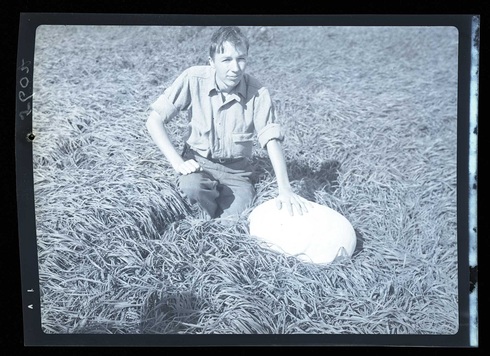The old adage, “A picture is worth a thousand words” can certainly be applied to the images in the Bell Museum of Natural History collection. And, as it has been my experience, a single picture can also send you in a thousand different directions in order to understand just what it is you are looking at.
Take for instance the following image:

– Sterling Brackett with giant puffball, September 17, 1937
After spending the better part of an hour providing captions for nearly one hundred photographs of snakes and frogs (Pseudacris nigrita triseriata, Cnemidophorus sexlineatus), I came across this image of “Sterling Brackett with giant puffball.”
What is a giant puffball? Who is Sterling Brackett?
Little did I know that asking these two simple questions to myself, simply to better understand the image I was looking at, could eat up the better part of a Friday morning…
What is a giant puffball?
Puffball is the common name for the species Calvatia gigantean, an edible mushroom that sprouts in grassy areas in the late summer and early fall. I found out more about the giant puffball on the Cornell Mushroom Blog (of course there are blogs for mushrooms!), where I received a great background on the fungus, as well as some puffball recipes – fritters anyone? A University of Wisconsin – LaCrosse botany professor created a website devoted to “Fun with Calvatia, giant puffballs” that depicts several colleagues -professional scientists- posed with puffballs.
What did I learn? Giant puffballs are mushrooms, giant puffballs are delicious, and giant puffballs are fun.
Who is Sterling Brackett?
A Google search for “‘Sterling Brackett’ MN” gave me a result with Walter J. Breckenridge in the description, preparator and curator at the Museum of Natural History in 1937, and the man that took Sterling’s photo with the puffball. Brackett is mentioned in the preface of Breckenridge’s book Reptiles and Amphibians of Minnesota, which was published in 1944 (also a clue to the hundreds of snake and frog images). Breckenridge lists Brackett among a handful of names as “assistants at various times in the Minnesota Museum of Natural History.”
So, if Brackett assisted at the University’s natural history museum, he must have attended or been associated with the University at some point. I abandoned Google and immediately navigated to the Digital Conservancy. The wealth of information about the University of Minnesota contained within this digital repository is astounding – meeting minutes, planning documents, press releases, you name it. Using a variety of historical University reports contained within the Conservancy, I was able to find and confirm Brackett’s identity. In the Publications of the Faculties, 1937, Brackett is listed as a Teaching Assistant in Zoology, next to the reference of a paper he published in the Journal of Parasitology. Brackett is also found in the Budgets, 1935-1936 and Budgets, 1936-1937 listed as a Teaching Assistant in the Department of Zoology.
I checked the Commencement Program, 1935 to find that Sterling Brackett graduated with a Bachelors of Arts in the College of Science, Literature, and the Arts that year. In the U’s Commencement Program, 1937, “George Sterling Brackett” is found under the listing of recipients of the Masters of Arts degree in the Graduate School:
George Sterling Brackett
B.A. ’35 University of Minnesota
Major, Zoology
Minor, Bacteriology
Thesis, Description and Life History
Of the Nematode Dracunculus
ophidensis n.sp. from Thamnophis
sirtalis with a Revision of the
Genus Dracunculus
While completing his master’s degree, according to the Student/Staff Directory 1936-1937, Brackett lived at “1000 University av se, At 4937.“
Brackett continued in his appointment as a teaching assistant in 1936-1937, 1938-1939, and then the trail runs cold for George Sterling Brackett in the Digital Conservancy results.
What did I learn? Sterling Brackett was a Teaching Assistant in the Department of Zoology who accompanied Walter J. Breckenridge on a field study as an assistant to the Museum of Natural History in 1937. You can read his master’s thesis regarding the Dracunculus, which was published in the Journal of Parasitology in 1938, on JSTOR.
I left for work this morning with no plans for my Friday night. One single image has provided me with dozens, and I’m sure thousands if I apply myself, ideas for fun Friday night activities. How about a nice slice of mushroom pizza and an article about nematodes?